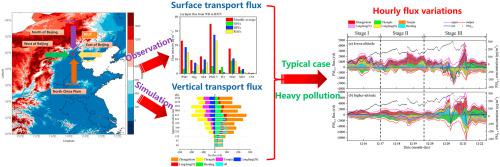当前位置:
X-MOL 学术
›
Atmos. Environ.
›
论文详情
Our official English website, www.x-mol.net, welcomes your
feedback! (Note: you will need to create a separate account there.)
Characterization of multiple atmospheric pollutants during haze and non-haze episodes in Beijing, China: Concentration, chemical components and transport flux variations
Atmospheric Environment ( IF 4.2 ) Pub Date : 2021-02-01 , DOI: 10.1016/j.atmosenv.2020.118129 Hanyu Zhang , Yi Xing , Shuiyuan Cheng , Xiaoqi Wang , Panbo Guan
Atmospheric Environment ( IF 4.2 ) Pub Date : 2021-02-01 , DOI: 10.1016/j.atmosenv.2020.118129 Hanyu Zhang , Yi Xing , Shuiyuan Cheng , Xiaoqi Wang , Panbo Guan

|
Abstract Characteristics of submicron particulate matter, including its components, during December 5–30, 2016, were comprehensively investigated in Beijing. The surface transport flux was calculated as well as the cross-border transport influence of Beijing and the North China Plain (NCP) on Beijing University of Technology (BJUT) based on the non-refractory submicron particles (NR-PM1) and species, PM2.5, and gaseous pollutant observations, together with wind vectors. The Weather Research & Forecasting (WRF) and Comprehensive Air Quality Model with Extension (CAMx) were applied to demonstrate the vertical PM2.5 flux distribution. These results showed that the monthly average concentration of NR-PM1 was 86.1 ± 86.5 μg m−3, with organics forming the major fraction (49.2 ± 11.1%), followed by NO3− (19.1 ± 6.3%), SO42− (15.8 ± 6.4%), NH4+ (10.8 ± 2.6%), and Cl− (5.1 ± 2.9%). The accumulation and dissipation of pollutants were related to the wind vector, with higher concentrations in the southern and eastern directions with low wind speed (WS), and lower concentrations in the northwestern direction with high WS. The net flux intensities were stronger from WB to BJUT for particulate matter and species, from EB to BJUT for gaseous pollutants and from NB to BJUT for all pollutants, which might attribute to the mutual influence of the pollutant concentration and wind vector. All the pollutant flux intensities were generally stronger in the heavy pollution episodes (HPEs) and red alert episodes (RAEs) than those in the non-polluted episodes (NPEs). Moreover, the PM2.5 net flux varied with the height; the maximum total net flux occurred at a height of 252 m. The variations in PM2.5 flux at the high-altitude layer were similar to those at the low-altitude layer, in which the former was approximately 1.5–2 times the latter. Furthermore, the external transport could exert important influence before reaching the most severe stage of pollution, while the local emissions had a greater potential to form heavy pollution extremes. Overall, the aforementioned results could provide the scientific support for proposing effective joint control measures and mitigating the adverse effects of heavy pollution in NCP.
更新日期:2021-02-01











































 京公网安备 11010802027423号
京公网安备 11010802027423号